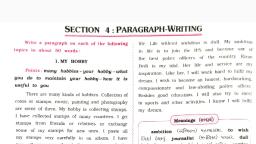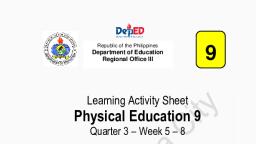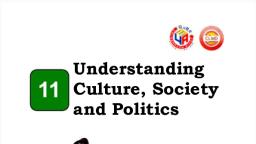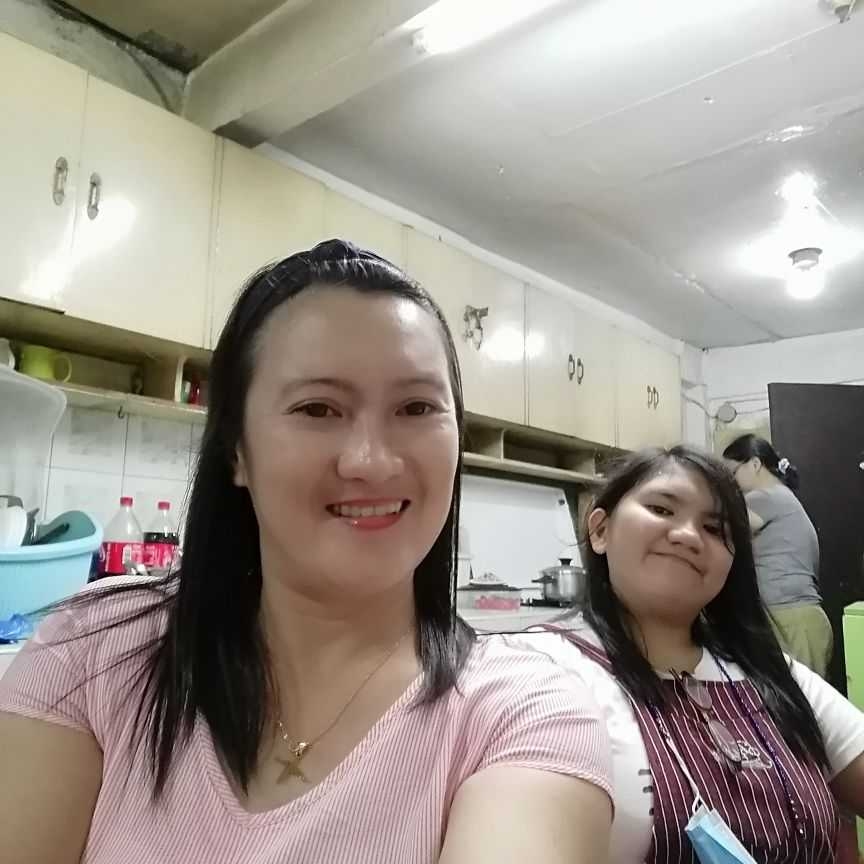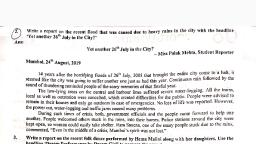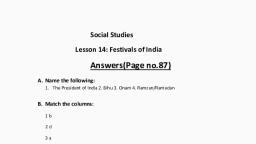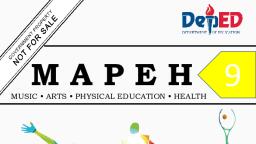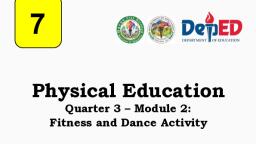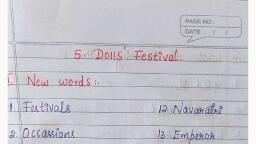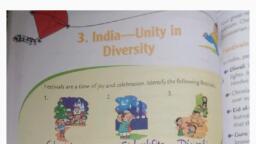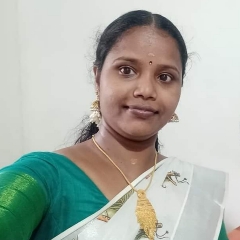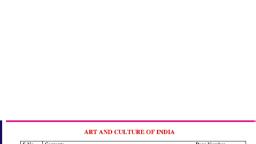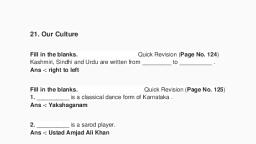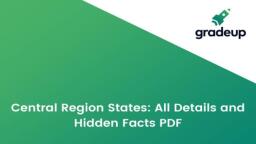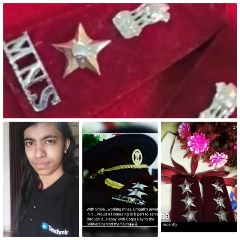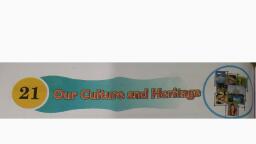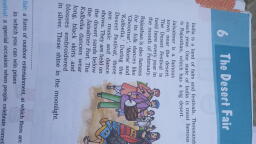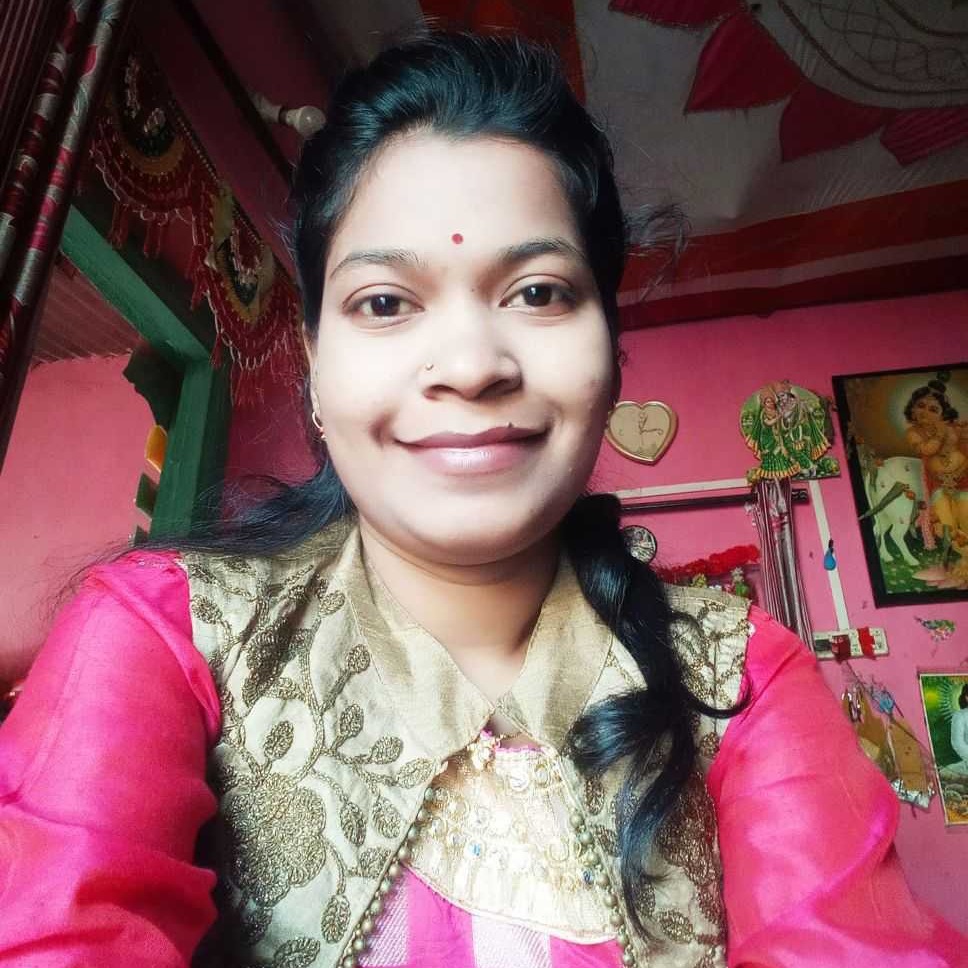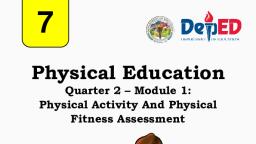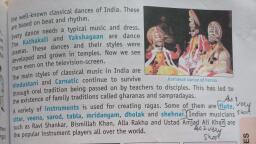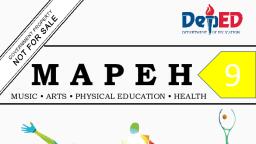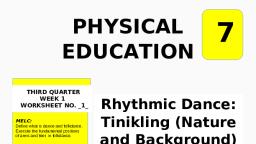Page 1 :
Republic of the Philippines, , Department of Education, Regional Office III, , Learning Activity Sheet, , Physical Education 9, Quarter 3 – Week 1 – 4, Festival Dances, , 9
Page 2 :
PHYSICAL EDUCATION – Grade 9, Learning Activity Sheets, Quarter 3 – Week 1-4, Festival Dances, Republic Act 8293, section 176 states that: No copyright shall subsist in any work of the, Government of the Philippines. However, prior approval of the government agency or office wherein the, work is created shall be necessary for exploitation of such work for profit. Such agency or office may,, among other things, impose as a condition the payment of royalties., Borrowed materials (i.e., songs, stories, poems, pictures, photos, brand names, trademarks, etc.), included in this module are owned by their respective copyright holders. Every effort has been exerted to, locate and seek permission to use these materials from their respective copyright owners. The publisher, and authors do not represent nor claim ownership over them., Published by the Department of Education, Secretary: Leonor Magtolis Briones, Undersecretary: Diosdado M. San Antonio, Development Team of the Learning Activity Sheet, Writer:, , MARIA ANGELA P. DIAZ, , Editors:, , SALVADOR P. ISIP, EPS I MAPEH, , Reviewers:, , SALVADOR P. ISIP, EPS I MAPEH, ALFONSO MIACO JR., EPS I MAPEH, ENCARNITA D. DEVERATURDA, EPS I MAPEH, , Illustrator:, Layout Artist:, , MARIA ANGELA P. DIAZ, , Management Team:, , MAY B. ECLAR, PhD, CESO III, Regional Director, LIBRADA M. RUBIO, PhD, CLMD-Chief, MA. EDITHA R. CAPARAS, EdD, EPS II, LRMDS, ENGELBERT AGUNDAY, EdD, EPS II, MAPEH, ADM, MERLINDA T. TABLAN Ed. D, CID Chief, ELLEN C. MACARAEG Ed. D, EPS I LRMDS, SALVADOR P. ISIP EPS I MAPEH, , Printed in the Philippines by ________________________, Department of Education – Region III, Office Address:, Telefax:, E-mail Address:, , ____________________________________________, ____________________________________________, ____________________________________________, ____________________________________________
Page 3 :
I. What I Need to Know, Fitness plays a very crucial role in our existence as human beings. It is a sustaining base of, our physicality that allows us to overcome challenges of our daily living. It is with fitness that our, eagerness to do things that we are capable of doing physically arise, which eventually leads us in, making our own lives, including that of others, better and more productive. We tend to challenge, ourselves to go beyond what we are already capable of doing and strive further to influence others, with what we think is better. Coupled with our desire to better ourselves is our urge to share it with, our fellowmen., This module introduces you to the value of festival dancing in the enhancement of your, fitness. You will be provided with activities in this festival dancing which will in turn lead to a, greater awareness of the right foods to eat, proper ways to manage your weight and of course, opportunities to maximize the enhancement of your fitness through festival dancing. It is expected, thereafter that such practices will be used by you to influence the lifestyle and fitness practices of, your immediate community., The module is divided into 2 lessons, namely:, •, •, , Lesson 1: Festival Dances, Lesson 2: Religious Festival Dance / Secular Festival Dances, a. Basic Movements, , After going through this module, you are expected to:, 1. Undertakes physical activity and physical fitness assessment (PE9PF-IIIbh-23, 2. Executes the skills involved in the dance( PE0PF-IIb-h-4), 3. Involves oneself in community service through dance activities the community( PE9PF-IIIgh-41), , II. What I Know, Let’s ASSESS you!, Directions: Below is a survey questionnaire that will reveal your involvement or participation in, festival dances. Copy it on your worksheet and accomplish it by placing a check mark (√) in, the box that corresponds to your response in each item., , YES, NO, 1. I know the name of the festival in our place., , 2. I am a member of a group representing our place in a festival, dance competition, , 3. I usually watch actual festival dancing competitions in other place
Page 4 :
4. I am fond of watching festival dances in YouTube or in TV shows., , 5. I recognize the value of festival dancing to my fitness., , 6. I contribute to the success of the festival in our place., , 7. I am proud of the festival in my place., , 8. I am a physically fit individual because I participate in festival dancing., , 9. I believe festival dancing can influence the fitness and well-being, of the community, , 10. The culture of the community is drawn and established through, festivals and festival dancing., , Upon interpreting your responses to the survey-questionnaire, what do those responses, reveal about your fitness and community involvement? Express and share your answer to the class, in 3-5 sentences., _______________________________________________________________________________, _______________________________________________________________________________, _______________________________________________________________________________, _______________________________________________________________________________, ___________________________________, , Lesson, 1, , Festival Dances, , III. What is It, Readings: Why Festivals?, Festival dances are cultural dances performed to the strong beats of percussion, instruments by a community of people sharing the same culture usually done in honor of a Patron, Saint or in thanksgiving of a bountiful harvest. Festival dances may be religious or secular in, nature. But the best thing about festivals is that they add to the merry-making and festivities where, they are celebrated, the reason why they are called festival dances after all. Festival dances draw
Page 5 :
the people’s culture by portraying the people’s ways of life through movements, costumes and, implements inherent to their place of origin., Some of the famous festivals in the country include Sinulog of Cebu, Dinagyang of Iloilo,, Ati-atihan of Kalibo, Aklan, Buyogan and Lingayan of Leyte, Bangus of Dagupan, T’nalak of South, Cotabato, Masskara of Bacolod City, Bambanti of Isabela, and Kadayawan of Davao. Many, others, especially from Luzon, are now paving their way to join the country’s festival of festivals,, the Aliwan Fiesta which is done in the month of April., Filipinos do festivals primarily to celebrate. There are a multitude of reasons for this reason., We celebrate our unity amidst the diversity of cultures and we celebrate our industry bringing, about a bountiful harvest. Festivals have been a consistent crowd-producing activity leading to, upliftment of a community’s economy due to its tourism and entertainment value. Basically,, festivals are a form of entertainment that attracts foreign and domestic tourists to visit a place, eventually leading to the elevation of the Filipino’s quality of life., Whatever festival we celebrate, be it done to honor a religious icon or celebrate our, industry. Festival dances are a reflection of the unity of the Filipino community that despite the, economic, social, environmental, cultural and political challenges we face every day, there can be, no other race more resilient than ours., Religious and Secular Festivals, As mentioned earlier, festivals may either be religious, in honor of a certain religious icon or, secular or non-religious, in thanksgiving or celebration of people’s industry and bountiful harvest., Maintaining, losing and gaining weight, By large, all basic food nutrients mentioned in table 3 are important in the study of fitness., The amount and kind of food that an individual consumes on a regular basis also serve as good, indicator of health and fitness. With regard to maintenance of appropriate weight, a well-balanced, diet and a regular exercise program are still the best fundamentally sound approaches to achieve, general fitness., So far the safest and most acceptable method of losing weight is to engage oneself in vigorous, aerobic activities together with a well-planned diet. Administration of diet pills, herbal medicines, and other fad methods appear to be less effective and sometimes unhealthy especially if weight, loss is associated with increased daily bowel movement or dehydration due to excessive, perspiration with very minimal or total absence of physical activity., On the other hand, on gaining weight, it has been found that the most effective approach is for one, to engage in weight resistance training together with a well-designed diet program. The popular, belief that one has to overheat in order to gain weight may be partially correct but with regard to, health and fitness, this approach may not be totally acceptable. Any excess in calories that are not, burned through physical activity is stored in the body and=are later transformed into fat. As, mentioned earlier, the risk of CAD (coronary artery diseases) and CHD (coronary heart diseases), is greater if this happens. In terms of weight resistance training, muscle mass has a greater weight, advantage that stored fat. Thus developing the muscles of the body will provide greater increase in, body weight and the risk of contracting common degenerative diseases is also minimized., Computing for one’s Total Energy Requirement (TER), Formula DBW (Desirable Body Weight) x Physical Activity
Page 6 :
Example: DBW = 59 kg. /athlete = Heavy physical activity, Thus, 59.0 x 45.0 (Energy requirement) = 2655 or 2,700 Calories, How to come up with the DBW (Desirable Body Weight)? Here’s how:, 1. Obtain your height in centimeters. Note that 1 inch is equal to 2.54 cm., 2. DBW in kilogram is obtained by subtracting one’s height from a constant factor 100., 3. DBW for Filipinos or DBW-F is adjusted by subtracting 10% of the obtained DBW value in item, number 2 above., For example:, Height: 5’2” = 62 inches, 62” x 2.54 centimeters. = 157.48 - 100, 57.48 - 5.74 DBW in kg., 105, 51.74 Or 52 DBW-F in kg., (You can read additional information Physical Education and Health 9 LM 3rd Quarter), Processing questions:, 1. Why is there a need for festivals? Festival dances?, 2. How do you think can festival dances help you in enhancing your fitness?, 3. What value do festival dances develop in community fitness?, , IV. What I Can Do, ACTIVITY 1: Fitness and Me, In this activity, you will be asked to integrate festival dancing, discipline, culture, cultural, literacy and social change or sense of community to fitness constructing a four-paragraph essay, that explains your interpretation of the hierarchical relationship of the elements indicated therein., Kindly refer to the figure below upon carrying out the task.
Page 7 :
FITNESS, , SOCIAL CHANGE, , CULTURAL LITERACY, , TRAINING FOR DISCIPLINE, , IMMITATION/MIMICRY/MOVEMENT IMPROVISATION, , You will need:, Fitness and festival dancing triangle, Pen, Worksheet, B. Objective:, Explain the benefits derived from participation in festival dancing., C. Daily Routine:, Accomplish the following before proceeding to the activity proper:, Warm-up:, HR Log: Activity Notebook, , Rubric for assessment:, Point Scale, 4, Advanced, 3, Proficient, , 2, Approaching Proficiency, 1, Developing, , Comprehensiveness, , Organization of Ideas, , All details included in the, triangle are provided and, explained excellently, 1 detail in the triangle is, missed but others are, provided and explained very, satisfactorily, 2 details are missed but the, others are provided and, explained satisfactorily, 3 or more details are, missed but the others are, , Unity,, coherence, and, technical correctness are, exhibited, Unity, and, satisfactory, coherence together with, technical correctness are, exhibited, Unity, improving coherence, and minimal technical errors, are exhibited, improving unity, improving, coherence, and, many
Page 8 :
provided and, satisfactorily, , explained technical errors, , Notes to the Teacher, The teacher must consider the prerequisite skills, needed in the development of this competency, including the background knowledge of the students in, Festival Dances., , ACTIVITY 2: LET’S DRAW YOUR MIND, Directions: Learners’ initial understandings on festivals will be activated through the following, activities:, 1. Enumerate in your worksheet the festivals that you know and are familiar with., 2. Make a short description about each of the festivals you have enumerated., 3. Classify whether they are religious (secular)/non-religious festivals., 4. Give at least 3 positive effects of festival dancing or participation/involvement in festival dances, to you, family and community., FESTIVALS, __________, , DESCRIPTIONS, ___________________, , RELIGIOUS/NON RELIGIOUS, ___________________________________, , Self:, ______________________________________________________________________________, ______________________________________________________________________________, _____________________________________________, Family:, ______________________________________________________________________________, ______________________________________________________________________________, _____________________________________________, Community:, ______________________________________________________________________________, ______________________________________________________________________________, _____________________________________________________________________
Page 9 :
Activity 3: FESTIVAL QUEEN DOLL, Procedure:, 1., 2., 3., 4., 5., 6., , Prepare any kind of hard paper: carton or hard board., Design your own Festival Queen, Make use of any recycled materials like magazine, newspaper, coloring materials etc., Upon creating your project make sure that the maximum size is 12 inches., Decide for the name your queen paper doll., Write a five-sentence paragraph describing your doll., , (Attached your Festival Queen Doll), Description:, ------------------------------------------------------------------------------------------------------------------------------------------------------------------------------------------------------------------------------------------------------------------------------------------------------------------------------------------------------------------------------------------------------------------------------------------------------------------------------------------------------------------------------------------------------------------------------------------------------------------------------------------------------------., , Activity 4: You complete ME!, , Write 5-10 sentences about on what you have learned from the lesson Festival, Dance., , As, a, grade, 9, student, Festival, Dance, is____________________________________________________________________________, ______________________________________________________________________________, ______________________________________________________________________________, ______________________________________________________________________________, ______________________________________________________________________________, ______________________________________________________________________________, ______________________________________________________________________________, _________________________________________________., , Activity 5: Festival Shout-Out!, (you can video/record your presentation), In this activity, you will be given opportunities to refine your understanding on the benefits derived, from engaging yourself in dancing activities. At the course of this activity, you will be made to, integrate your understanding on maintaining, gaining or losing weight, having an active lifestyle as, a means to achieving a sound mind in a sound body., You will need:
Page 10 :
VCD/CD player, Festival music, Pen, Worksheets, Costumes and props if necessary or available, Objective:, Appreciate the value of festival dancing to their fitness and well-being, Here’s how:, 1. Group yourselves according to your place of origin regardless of gender., 2. Identify with your group the leading industry in your own place., 3. Upon identification, make this a theme which can guide your creation of movement patterns and, combinations for your festival dance parade, 4. Integrate shouts that distinguish your festival from the other groups. This is called your festival, shout-out., 5. Make about 5 figures of 32 counts each., 6. Upon mastery, assemble yourselves in 4 columns with a distance of about two meters from, each other., 7. This time, perform your festival dance integrating your shouts in between figures or in the end of, the whole sequence in continuous progression. Do this in an open space or in your gymnasium, if, there’s any., 8. Below is you assessment guide:, (Note: if you don’t have any access on the internet, you can take a photo while doing the activity or, if you don’t have any gadget you can create a short narrative report you can write on any clean, sheet of paper), Point Scale, , Criteria, , 4, Outstanding, , Mastery and, Creativity, Displays high level, of mastery and, creativity as seen in, routine construction, relevant to the, identified festival, , 3, Very Satisfactory, , Displays mastery, and creativity as, seen in routine, construction but, with minimal, relevance of, movements to the, identified festival, Displays mastery, and creativity as, seen in routine, construction but, with no relevance, of movements to, identified festival, , 2, Satisfactory, , Energy and Fitness, Shows impressive, level of proficiency, in the execution of, steps and dance, combinations, displaying excellent, health-related, fitness level, Shows high level of, proficiency in the, execution of steps, and dance, combinations, displaying high, health-related, fitness level, Shows medium, level of proficiency, in the execution of, steps and dance, combinations, displaying, acceptable level of, , Behavior/Teamwork, Exhibits outstanding, level of discipline, and teamwork, before, during and, after the, performance of the, festival dance, routine, Exhibits very, satisfactory dance, discipline and, teamwork during and, after the, performance of the, festival dance, routine, Exhibits satisfactory, discipline and, teamwork before,, during and after the, performance of the, festival dance, routine
Page 11 :
health-related, fitness, 1, Needs, Improvement, , Displays low level, of mastery and, creativity as seen in, routine construction, and no relevance of, movements to the, identified festival, , Shows low level of, proficiency in the, execution of steps, and dance, combinations, displaying low, health-related, fitness level, , Exhibits improving, discipline and, teamwork before,, during and after the, performance of the, festival dance, routine
Page 12 :
IV. Assessment, I challenge you!, Directions: Read the statements carefully. Choose the letter of the best answer then write it on, your answer sheet., 1. Which of the following is a cultural dance performed to the strong beats of percussion, instruments by a community of people sharing the same culture usually done in honor of a, Patron Saint or in thanksgiving of a bountiful harvest?, a. Cultural dance b. festival dance, c. folk dance, d. social dance, 2. The following festivals are celebrated in honor of Sto. Niňo, EXCEPT ONE:, a. Ati-atihan, c. Dinagyang Festival, b. Bangus Festival, d. Sinulog Festival, 3. Each festival is uniquely different with the other festivals. What do you call the gathering and, battle of all festivals within the country?, a. Aliwan Fiesta, c. Festival of festivals, b. Dinagyang Festival, d. Mother of all festivals, 4. Which of the following is a source of energy that we need in order to perform our daily routine?, a. Bread, b. cereals, c. vegetables, d. all of the above, 5. How can festival dancing contribute to one’s fitness and well-being?, a. It reduces the risk of cardio-respiratory diseases, b. It facilitates teamwork and sense of community, c. It maximizes our use of energy and enhances cardiorespiratory health, d. It is a good form of exercise, 6. What is the Total Energy Requirement (TER) of a student with a weight of 50 kg performing a, moderate festival dancing activity?, a. 1000 cal., b. 1500 cal., c. 2000 cal., d. 2500 cal., 7. Why is festival dancing an excellent way to reduce or maintain one’s weight?, a. It exhausts one’s energy to the extent that he can hardly catch his breath off., b. It burns desired number of calories stored in the body depending on the intensity of the, activity., c. It easily burns fats off., d. It makes one achieve a desired body figure., 8. How can one best benefit from festival dancing activities?, a. They help one achieve a personally active lifestyle, b. They contribute to the enhancement of community awareness, c. They develop one’s awareness of his own and others’ culture through, d. All of the above, , festivals, , 9. The following EXCEPT ONE may result from having a sedentary lifestyle:, a. Lung cancer, b. Overweigh and obesity, c. Coronary artery and coronary heart diseases, d. Diabetes, 10. If an individual could hardly catch his breath off while performing festival dances, what is the, intensity of his activity?, a. Heavy, b. light, c. moderate, d. moderately light
Page 13 :
V. Additional Activities, Honesty Quiz Bee!, In this activity, your knowledge on festival dances and their fitness aspect will be assessed, through an honesty quiz bee. It’s dubbed as honesty quiz bee because you will be accountable, with keeping track of your own score., You will need:, - Flashcards, - PEN/PENCIL, - Individual score sheets, - Festival and fitness questions, - MEMBER OF THE FAMILY, B. Objectives:, 1. Describe festival dances and its effect on fitness, 2. Show preparedness to process to the next phase using result of assessment, C. Daily Routine, Accomplish the following before proceeding to the activity proper., Warm-up: Exercises (5 minutes), • Inhale/ Exhale, • March, • Jump, • kick, • Rotation (head, shoulders, arms, hips, thigh, feet), • Inhale/ exhale, HR Log: Activity Notebook, Here’s how:, 1. Form 6 columns. In cross sitting position, prepare your own flashcard and chalk together with, your score sheet because we’re having an honesty quiz bee., 2. The quiz bee is divided into 3 categories namely easy, average and difficult. There will be 5, easy questions worth 1 point each, 5 average questions of 3 points each, and 5 difficult, questions of 5 points each., 3. Each question will be read twice. Wait until the teacher says “Go!”, before you write your answer, on your flashcard. Ten seconds will be given for you to write your answers., 4. As you hear the teacher says, “Time’s Up!” stop writing and raise your flash cards for checking., Teacher will reveal the answer. If you got it right, write a straight line corresponding to your, score. If you got it wrong, write x for that particular number., 5. The sequence continues until all the questions shall have been read, answered and scored., 6. When your name is called, announce your score. Or write it on your activity sheet.
Page 14 :
Easy Category:, These are dances performed in celebration of festivals., What festival is celebrated in January in Kalibo, Aklan?, To whose honor is the Dinagyang festival offered?, Festival Dance that honors patron saint., Festival dance that promotes thanksgiving or bountiful harvest., Average Questions (Answers are to be demonstrated correctly):, What Is the PMHR of a 16 year old student?, What is the PMHR of a 20 year old student?, What is the step pattern of?, What is the lowest THR of 20 year-old individual?, What is the highest THR of a 20 year-old individual?, Difficult Questions:, -How can knowledge in determining THR range help in improving one’s fitness through activities, like festival dancing?, Give at least one fitness benefit of festival dancing?, -What is the range of THR of a 16 year-old student?, -Give a pair of non-locomotor movements that complement each other, -How can you influence your community in improving its fitness through festival dancing?, Where do you belong?, Assess your performance in the quiz using the following rating scale:, 40-45 Advanced, 35-39 Proficient, 30-34 Approaching Proficiency, 20-29 Developing, 19 and below Beginning, SCORE CARD, EASY CATEGORY, , AVERAGE QUESTIONS, , DIFFICULT QUESTION, , 1., , 1., , 1., , 2., , 2., , 2., , 3., , 3., , 3., , 4., , 4., , 4., , 5., , 5., , 5
Page 15 :
Activity 3, 1. H, 2. E, 3. I, 4. D, 5. C, 6. G, 7. B, 8. J, 9. A, 10.K, , Assessment, 1. B, 2. B, 3. A, 4. C, 5. C, 6. C, 7. B, 8. D, 9. A, 10.A, , VI. Answer Key
